Bust Treatments
In 1940, the Hollywood actress Hedy Lamarr [1914-2000] organised to meet the avant-garde musician and composer George Anteil [1900-1959]. After a while their conversation shifted to concerns about the war in Europe and, as unlikely as it sounds to anyone that does not know the story, this led to them collaborating on developing a patent for a torpedo guidance system that used ‘frequency hopping’ to prevent the wireless signal from being jammed by the enemy (U.S. Patent No. 2,292,387).
What is sometimes lost from this story is the original reason Hedy had wanted to meet George. It was not to develop a military device but rather to consult him about her glands. George Anteil considered himself an expert on endocrinology and had written a number of articles on the subject of glands for ‘Esquire’ magazine that repeated a lot of pseudo-science circulating at the time. One of these articles, ‘The Glandbook for the Questing Male’ – a ready reckoner on how to use ‘hormonal science’ to recognise sexually available women – had apparently been read by Louis B. Mayer [1884-1957]. Despite promoting her as the ‘most beautiful woman in the world’, Mayer had suggested to Hedy that she should try to increase her bust size and had recommended that she contact George to see if hormones would do the trick.
The idea of using hormones to increase the size of the bust was a relatively new idea in the late 1930s but it was only one of a number of treatments for improving the size and firmness of the bust, which included pills, massage, creams, exercises, vacuum appliances, and the use of electricity, that were used right through the twentieth century. Even during the 1920s, when curves were out of fashion, the lack of a suitable bust was still a concern to many.
For developing the bust, pat on some cocoa butter or olive oil after the [bust improving] exercises and stroke gently upward with the palms of the hands six times; do not use any pressure on the bust. Swimming is one of the best exercises for the development of a shapely bust. Deep breathing exercises should be taken daily to increase the vitality and improve the carriage of the flat-chested woman.
(Leeds & Kaji, 1927, p. 270)
Diet, exercise and posture
As well as recommending foods like dairy that would put on weight, most beauty columnists writing on the subject in the first half of the twentieth century – and some after that – suggested undertaking a course of exercises to enhance the bust. The practice was based on a simple idea, namely, that if the muscles of the chest were strengthened then the breast would be better supported.

Above: 1908 Illustrations emphasising the importance of chest musculature to the appearance of the breast.
As well as the chest muscles, lung development was also considered to be important; larger lungs meant a larger chest. As Margaret Mixter noted: “Deep breathing has much to do with having a good figure. If the chest is flat and contracted, as must be if the lungs are not filled, a woman cannot make a good appearance” (Mixter, 1910, p. 206). Most of these exercise routines were taken from programs developed by the Physical Culture movement.
To Increase the Bust Measurement:—(1) Lift up the arms until they make a line horizontal with the shoulders. Bring the arms forward in front, reaching out as far as is possible, but keeping the body rigid. Next spread back the arms with a slow gentle motion as far as possible—do not let them drop—at the same time filling the lungs as full of air as possible. Do this ten times. (2) Lift the arms outward with an easy gentle motion up above the head, reaching as high as possible, but keeping the heels on the floor. Then lower the arms again gently to the first position. Do this ten times. While lifting the arms inhale, while lowering them exhale; each action of the lungs is to be as full as possible. This breathing exercise is of great importance. No corsets should be worn while practising these exercises, and they should be practised morning and evening.
(Cyclax, 1908 p. 17)
In addition to breathing exercises, good posture was emphasised to pull the shoulders back and push out the chest.
Spend five minutes every morning and evening at the open window inhaling fresh air with the mouth shut, and the hands holding the window sash on a level with the shoulders. Take a deep breath, lifting the shoulders, as it were; hold the breath several moments, and let it go slowly. Repeat this for five minutes. This breathing can also be practised during the day while walking whenever you think of it.
Then in walking try to forget the feet as much as possible. Keep an “up” feeling, the head up and back, the chest up and forward. This will attract the vitality to the head and chest, and the habit established will not only help develop the chest, neck, and shoulders, but will also give lightness of foot and easy grace in walking.(Woodbury, 1911, pp. 360-361)
By the 1930s, the lungs were largely forgotten and strengthening the chest muscles became the main focus for bust exercises. One of the simplest routines was simply to put the palms of the hands together in front of the chest and clench in time with the phrase “I must, I must, improve my bust”. Other regimes, such as this one by Helena Rubinstein, were more complicated.
Bust: to firm and lift.
11. Lie on floor. Arms out to the side. Raise chest and shoulders, chin tilted upward and weight on the back of head. Relax. Lower chest and shoulder. Repeat 5 times. Relax.
12. Sit or stand. Raise arms shoulder-high and out to sides. Bend upper arm at right angles and clench fists. Pull arms, shoulders, head well back. Bring elbows together in front of body. Lower head, neck and chest forward. Return to first position. Make a complete circle with bent arm, moving from shoulder. Movement of bent arm is forward – upward – backward – downward.
13. Stand erect. Raise arms in front of chest, elbows bent, hands clasped. Resist hard with right arm and hand as you pull with the left until right hand is in front of left shoulder. Alternate. Repeat 5 times. Relax. Repeat 5 times. Relax.(Rubinstein, 1936, p. 179)

Above: 1958 Bust exercises using the weight of a book to generate resistance and build chest muscle strength.
Generations of women continued to hope that daily repetitions of bust exercises would have a desirable effect. Some retailers were able to generate an income from this hope by combining an exercise routine with a spring-loaded or elastic device, most of which were repurposed from the health and fitness industry. A good example was the Mark Eden Bust Developer which came with an instruction booklet outlining the bust exercises to be followed during the Mark Eden Developer and Contouring Course.

Above: The Mark Eden Bust Developer. A patent was filed for the clam-shell device in 1966 (U.S. No. 3,497,216). The product was on sale until the early 1980s but disappeared after the company was convicted of mail fraud.
Bust creams and massage
Bust creams were another popular treatment for improving and/or firming the bust. They were a favourite with beauty salons as they entailed using a product that could be sold. Two broad types can be distinguished – ‘flesh-making’ and ‘flesh-firming’ – with a good deal of overlap between the two.
Flesh-making
The ‘flesh-making’ bust creams were usually a type of skin food or muscle oil similar to preparations applied to the face. The reason given for using them was also the same: to supply ‘food’ to help build up the ‘undernourished tissues’. As with other skin foods and muscle oils natural fats and oils were used, with lanolin being regarded as particularly valuable. Petrolatum (Vaseline) was generally avoided as it was not believed to be absorbed by the skin.
Powdered Almonds tbsp. 1 Cocoa Butter oz. 1 Fresh Mutton Tallow oz. 1 Fresh Beef Tallow ozs. 2 Cod Liver Oil ozs. 2 Olive Oil oz. 1 Melt the fats over warm water, add the almonds and mix well. Let it get solid before sealing in a wide-mouth jar. To apply, first wash the breast in hot water and soap, and rub in a small amount of the developer. Massage each night with vibrator.
(Furlong, 1914, p. 124)
See also: Skin Foods and Muscle Oils
Flesh-firming
The ‘flesh-firming’ bust creams were again based on facial cosmetics but the firming types generally contained compounds used in skin tonics and astringents. This one quoted by Woodbury is a copy of an earlier French recipe for a Pomade Raiffermissante (Firming Cream).
Oil of sweet almonds 6 oz. White wax 3 oz. Tincture of Benzoin 1½ oz. Rosewater 1½ oz. Pulverized Tannin 6 dr. (Woodbury, 1911, p. 361)
In the nineteenth century it was recommended that this cream be lightly applied before retiring but not rubbed in. It was then followed by painting the breasts over with a pure elastic collodion, to form a sort of breast plate that helped support the relaxed tissues overnight (Fletcher, 1899. p. 434).
Some recipes for bust-firming preparations were little more than liquid astringents.
White Brandy ozs. 5 Camomile Water (strong) ozs. 2 Alum water (strong) ozs. 2 Use as a wash every day, it will restore the firm contour of the breast.
(Furlong, 1914, p. 125)
See also: Skin Tonics, Astringents and Toners
Massage
It was generally recommended that a bust cream be applied as part of a breast massage. As massage was regarded as a form of exercise in the early part of the twentieth century, it was believed to be able to build up tissue by itself and so worked in conjunction with the bust cream.
See also: Massage, Wrinkles and Double Chins
As with facial massage there was some variation in the routines recommended but most writers on the subject suggested that gentle circular motions in an upward direction were best. As with the face, massage rollers were sometimes suggested as a substitute for hand massage.
Massage of these sensitive parts must be very carefully and discreetly employed, and the manipulations must be very gentle. It is most injurious to allow a young girl’s bosoms to be handled at all. Nature provides this charm for all women, and it can be secured in the natural way. For her the effective remedy can always be found in proper exercise and tissue-building food. Although sometimes unctions with almond, olive, or cocoa-nut oil prove beneficial, absolutely no effect need be expected from them unless the physical conditions are such that the whole body is gaining flesh, and the skin through baths and massage has been made to assimilate nourishment in this way. …
When the services of an expert masseuse cannot be had, the massage rollers will often be found very helpful in self-manipulation. They come in various shapes and sizes, and sometimes in sets for different parts of the face and body.(Fletcher, 1899, p. 437)

Above: 1898 A mechanical roller being used in a bust treatment.
After they became available, electrical vibrators were also popular for massaging the bust. These were often preferred in salon treatments as they placed an instrument between the operator and the client so the client’s breast was not touched by hands but many salons used direct manipulation.
Massage of the breasts should be most carefully done, after washing them with warm water and applying a good skin food. The movement should be performed with the flat portion of the hand, rubbing in a circular fashion, around and around, and finishing with a quick dash of cold water. …
In this connection the use of the vibratory massage taking care that the speed is not too great, and using discretion in applying pressure, will often be found most excellent for the purpose not only of increasing the size of the breasts, but also for making the hollows in the neck less apparent. … [T]he treatment may be easily given, and when coupled with proper finger manipulation and the use of nourishing ointments will be found really of much benefit.(Lloyd, 1907, pp. 226-227)

Above: 1907 Vibratory breast massage in a Marinello salon.
Additives
Along with the oils, fats, and astringents, other specifics were soon added to bust creams. One that seems to have been widely recommended was first suggested by Dr. R. Vaucaire of Paris. Known as galega or goat’s rue, it was derived from the plant Galega officinalis. It was used in Europe for many years to bring on milk in domestic animals, and for this reason found its way into creams and pills designed to enhance the bust.
Galega is the internal remedy used by most mail order specialists and at local institutes for bust development, and it is claimed that wonderful results have been obtained in many cases, not only as a bust developer, but as an aphrodisiac for women. The discovery of this drug was due to its extensive use in the central parts of Europe, where it is given to cows to increase the quantity of their milk from thirty to fifty per cent.
(Covey, 1905, p. 277)
After 1930, other biological compounds began to be added to bust creams. The most important of these were hormones but most of the biological compounds that were popular in France, such as placental and embryo extracts, were also used. Although these compounds could be incorporated into creams many were sold as serums, particularly in France.
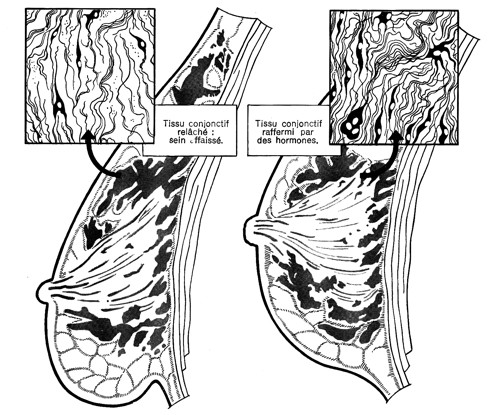
Above: 1935 Part of a French magazine illustration demonstrating the supposed action of hormones on breast tissue. Some women had hormones and placental extracts injected directly into the breast tissue under medical supervision.
Although the use of animal hormones in beauty creams has ceased for the most part, as with face creams, phytoestrogens are now widely incorporated into bust creams, assuring results similar to those promised in the past.
See also: Hormone Creams, Oils and Serums, Placental Creams and Serums and Embryo Extracts
Vacuum suction
Breast developers that rely on the generation of a partial vacuum were made throughout the twentieth century. The vacuum could be generated by the use of a hand or foot pump, by gravity fed water from an elevated container, by water pressure from a domestic or commercial water tap, or by using an electrical pump. More expensive modern versions currently on the market use a computer chip in a manner similar to devices that measure blood pressure.
See also: Vacuum Suction
No matter how they were powered, all these devices worked in the same way; by pulling fluids into the breast. The size of the breast and the cup size of the device could affect the seal, so the selection of an appropriately sized cup was ideal, something that was not always possible with products sold by mail-order. Instructions for using these devices varied, with some manufacturers recommending they be used for 10-20 minutes each day while others requiring much longer times, even overnight.
1. Assemble the air pump, hose and mammary cup.
2. Apply a small quantity of cold cream to the nipple to prevent any friction.
3. Hold mammary cup firmly against the chest. Mark down your measurement and compare your measurement every day.
4. Push the air controller and squeeze the rubber bulb until the breast is enlarged by 2 centimetres.
5. Slowly release the air controller to release air and relax the breast.
6. Repeat the procedure for 15 minutes on each breast, once in the morning and once in the night.(A set of instructions modified from a modern bustline increaser manual)
Evidence of the effectiveness of these devices is mixed but it would appear that if benefits were to be gained then using a lower negative pressure over a longer period of time was better than trying to get immediate results by using a higher setting. Using a high negative pressure could also rupture small blood vessels and damage other breast tissue. This would not have been a major problem with earlier devices run by hand pumps or water, unless the operator was particularly zealous, but the same could not be said of machines powered by an electrical pump.
Another annoyance – apart from the discomfort of wearing something like this overnight – was that the cup produced a red ring around the breast which took time to disappear.
Douching
Many beauty writers suggested using cold or iced water as an astringent to firm up the breast. This could be done by taking a cold shower or spraying the breast with cold or iced water. If a strong spray of water was used then it would have an additional stimulating effect, somewhat akin to a massage. The breast douche was an alternative to this practice.
The devices were sold primarily in continental Europe, where douching of particular body parts was more widely practiced, and I have yet to find an example of one made in the English speaking world. Although they look superficially similar to vacuum-suction machines, some of which were also attached to taps, they should not be confused with them. The former were used mainly for bust enlargement while the later were employed to firm the breast.
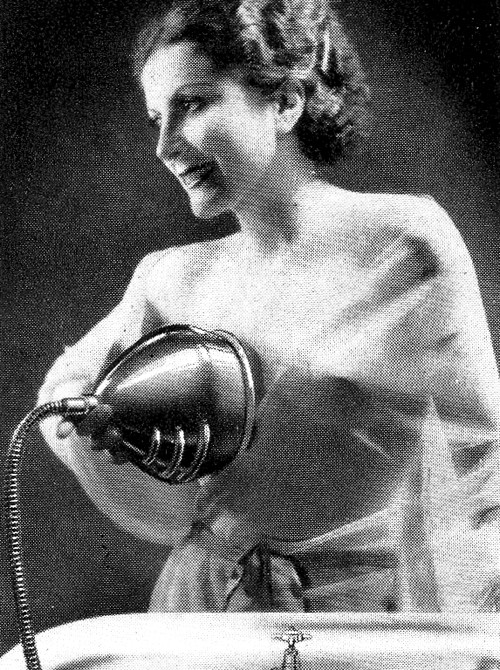
Above: 1935 A device for douching the breast made by the French company Le Massosein.
The dome-shaped apparatus was connected to a cold-water tap and was used alternatively on each breast. A good seal between the cup and the chest was necessary, otherwise the water sprayed over the breast would go everywhere. Turning on the tap for 30 seconds to a minute applied a firm but gentle pressure to the breast, while the low temperature caused the skin covering the bust to contract. Collectively this generated a feeling that the breast had firmed.
Electrical treatments
Although clients could do exercise routines at home, women who found this too rigorous could opt for a beauty treatment that used electrical currents to contract and supposedly strengthen the chest muscles. In the early part of the twentieth century faradic currents were used to achieve this but interrupted direct, and interferential currents were also employed later in the century. Without getting into the specifics of each of these electrical modalities, all of these treatments produced muscle contraction. This was sold to the clients as being equivalent to exercise – which explains why these devices were also used in weight reduction programs. The treatments would appear to be having the desired result to a client lying on a couch experiencing repeated muscle contractions generated by the electrical current.
Although the pectoral muscles of the chest would seem to be the most likely candidate for such a treatment, the platysma muscle of the neck was also singled out. This muscle runs in a broad sheet covering the neck and upper chest and was frequently targeted in treatments to reduce a crêpy neck.
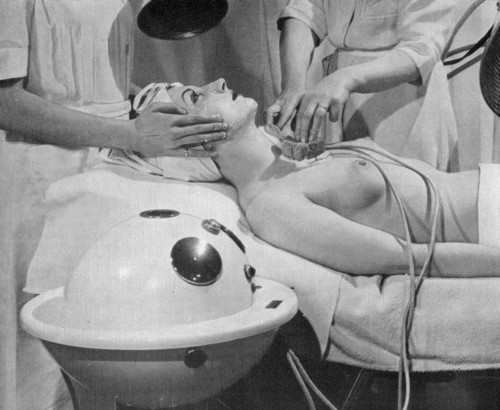
Above: 1955 This staged picture from a French salon shows two treatments being demonstrated. The one on the right is using an interferential electrical current to tone the platysma muscle of the neck (Mayer, 1955).
See also: Faradic Treatments and Interferential Treatments
High frequency currents were also used in some salons to stimulate and invigorate the breast tissue.
See also: High Frequency
Finally, although evidence is scarce, I would expect some bust treatments to have combined serums with iontophoresis. This would seem most likely to have occurred in French salons or those salons that used French products.
See also: Iontophoresis
Bust reduction
Some women were concerned about their breast being over rather than under-developed and looked for treatments to reduce the size of their bust. Universally the beauty profession considered this to be a much more difficult task.
Dr. Vaucaire, of galaga fame, suggested astringents and cold compresses. There were also a range of reducing lotions, reducing soaps, and bath salts recommended for weight loss that were used with the hope that the bust would also be reduced. Some beauty writers also suggested bust exercises to firm the breast followed by hot and cold sponges or bathing the breasts in salt water, the idea being that as large breasts tended to sag, firming them up would help.
Bathing in cold water is helpful in hardening the bust. The surface is chilled, and to warm it up, some body-fat is burned up. This treatment is beneficial only when a good warm reaction is obtained. Put one-half a teaspoon of alum in the basin of water to act as an astringent.
It is not an easy matter to reduce an overly large bust, and it is not always possible to do so, whatever means are used. A combination of reliable methods gives most promise of success. Exercise that brings into play the muscles of the chest stimulate the circulation through the bust and wear away the deposits of excess fat. They should be done slowly but with force.(Leeds & Kaji, 1927, pp. 273-274)
However, all in all, most beauty writers thought that little could be done for a large bust other than wearing an appropriate support or undergoing breast surgery.
Updated: 19th January 2015
Sources
Covey, A. D. (1905). The secrets of specialists. Detroit: Physicians Supply Company.
Cramp, A. J. (Ed.). (1921). Nostrums and quackery. Articles on the nostrum evil, quackery and allied matters affecting the public health; reprinted, with or without modifications, from the journal of the American medical association (Vol. 2). Chicago: American Medical Association.
The Cyclax Company. (1908) The cultivation and preservation of natural beauty. London: Geo. Pulman & Sons, Ltd.
Fletcher, E. A. (1899). The woman beautiful. A practical treatment on the development and preservation of woman’s health and beauty, and the principles of taste in dress. New York: W. M. Young & Co.
Furlong, P. (1914). Beauty culture at home. A complete course in shampooing, facial and scalp massage, hair coloring, manicuring, chiropody, developing and reducing—also hundreds of reliable formulas for beauty preparations, including cold creams, skin bleaches, liquid and dry powders, rouges, depilatories for removing superfluous hair, shampoo mixture, hair tonics and restorers, curling fluids, bust developing, reducing, remedies for wrinkles, pimples, blackheads, freckles, liver spots, sunburn, eyes, mouth, hands, feet, exercises, diet and miscellaneous valuable hints—as taught at Paulette School. Washington: Author.
Gordon, J. (1934). Home beauty treatments solving every woman’s beauty problems. London: John Lane, The Bodley Head Ltd.
Leeds, L., & Kaji, H. M. (1927). Beauty and health a practical handbook. Philadelphia: J. B. Lippincott Company.
Lloyd, E. (1907). The skin. Its care and treatment (3rd ed.). Chicago: McIntosh Battery and Optical Company.
Mayer, C. (1955). La médecine au service de la beauté. Paris: Amiot-Dumont.
Mixter, M. (1910). Health and beauty hints. New York: Cupples & Leon Company.
Rubinstein, H. (1936). This way to beauty. United States: Dodge Publishing Company.
Woodbury, W. A. (1911). Beauty Culture. A practical handbook on the care of the person, designed for both the professional and private use. New York: G. W. Dillingham Company.
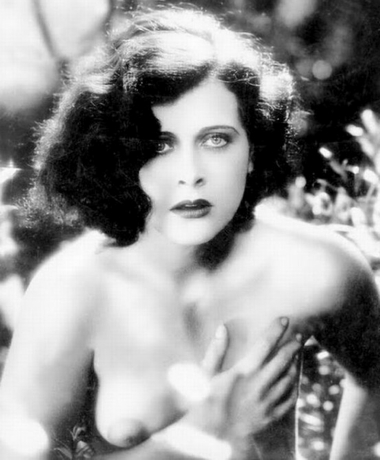
Hedy Lamarr (Hedwig Eva Maria Kiesler) aged 18, in the film Ecstasy (Elektafilm, 1933).
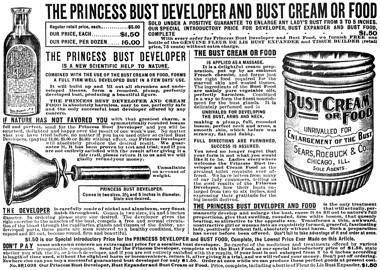
1897 Princess Bust Developer and Bust Cream.
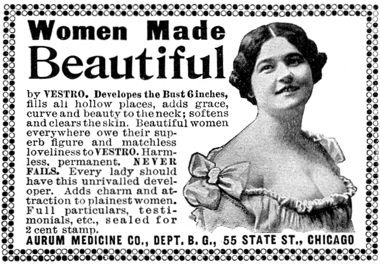
1899 The Vestro bust developer by the Aurum Medicine Company of Chicago. The company also sold Dr. Vorell's French Female Pills.
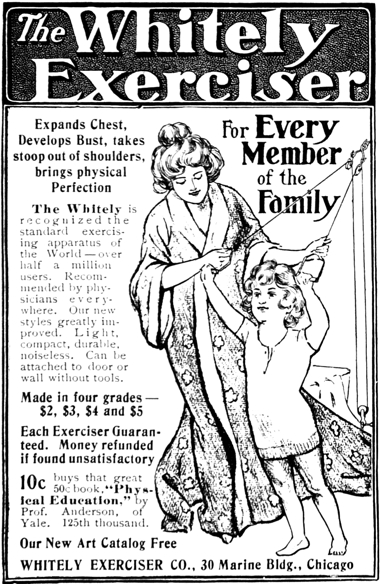
1900 The Whitely Exerciser that expands the chest, develops the bust, and improves the posture.
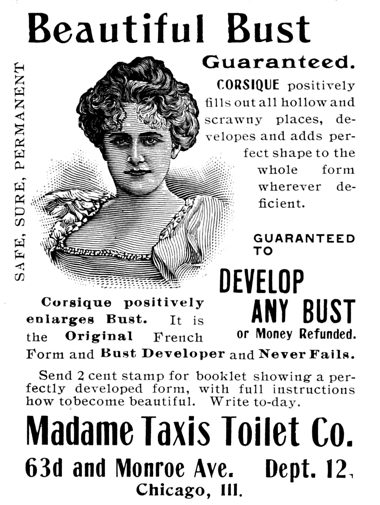
1901 Madame Taxis Toilet Company bust developer.
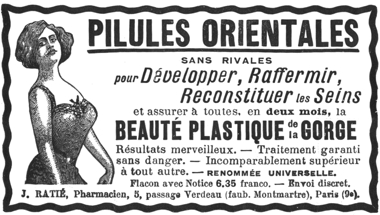
1906 Pilules Orientales. Bust development pills
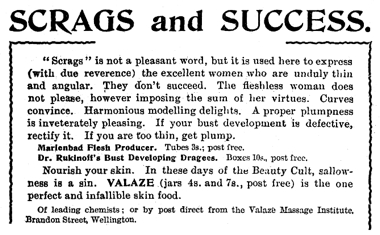
1908 Dr Rukinoff’s Bust Developing Dragees as sold by Helena Rubinstein in Australia and New Zealand. Dragee is just a fancy name for pill. Unfortunately their composition is unknown.
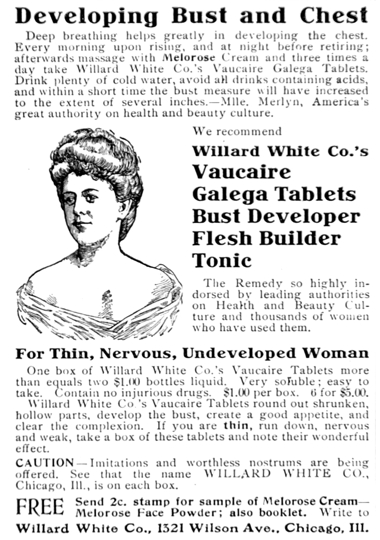
1908 The Willard White Company Vaucaire Galega Tablets.
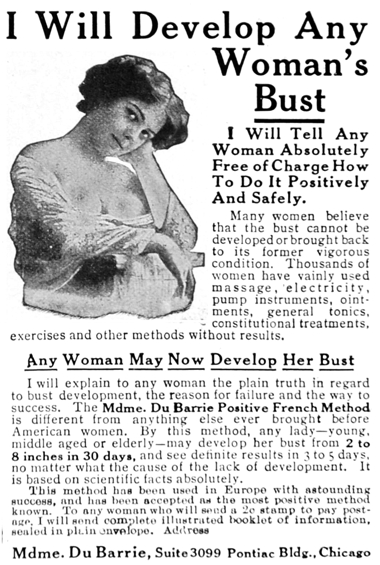
1912 The Madame Du Barrie Positive French Method of bust development.
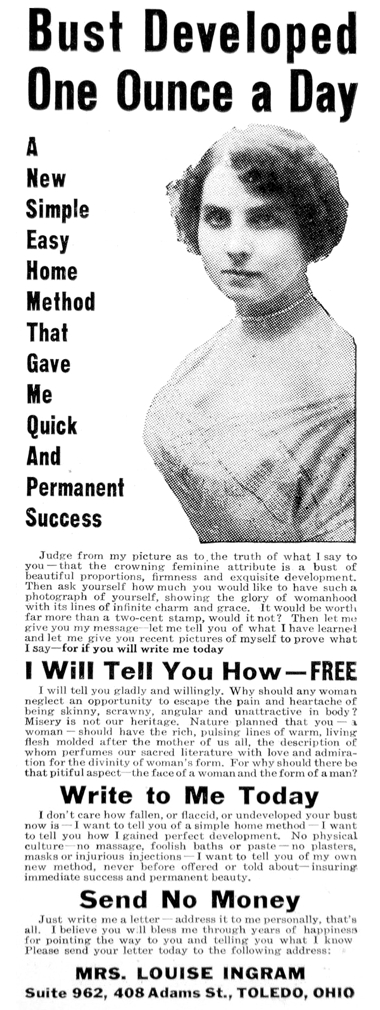
1912 Louise Ingram. “Bust Developed One Ounce a Day”.

1916 The Madame Hélène Duroy bust developer.
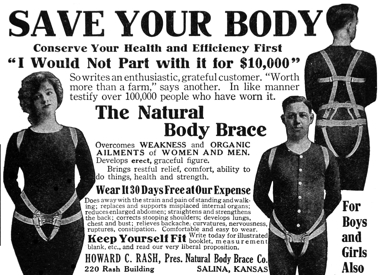
1920 The Body Brace from the Natural Body Brace Company. Advertisements for the braces, first patented in 1898, were generally directed at women to cure ‘weakness and organic ailments’. The straps pulled the shoulders back and pushed the chest forward thereby supposedly ‘developing the lungs, chest and bust’.
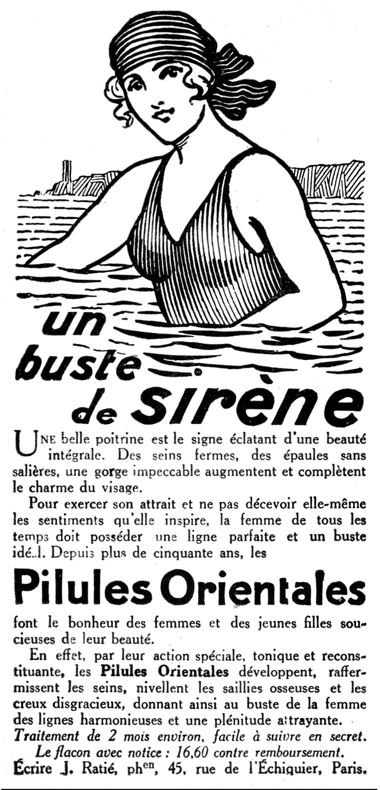
1926 Pilules Orientales.
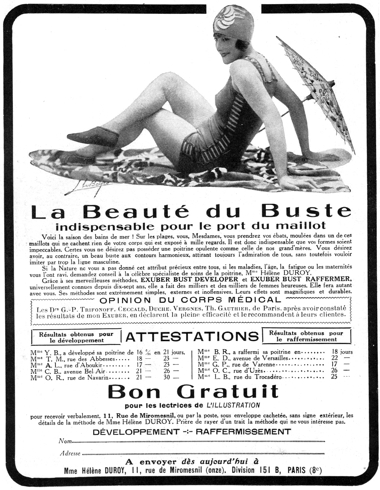
1928 Hélène Duroy. More revealing swimwear seems to be associated with a renewed interest in the breast.
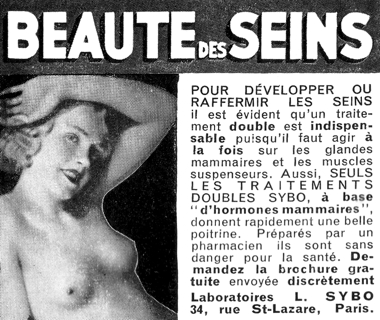
1935 Sybo bust developer with hormones.
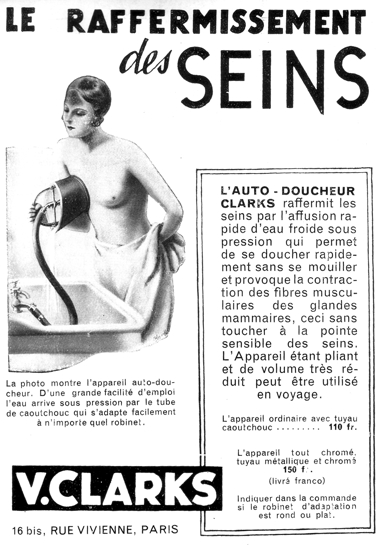
1935 Clarks Automatic Doucher.
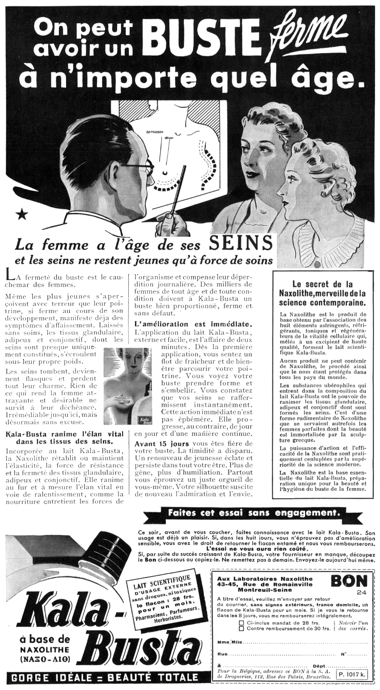
1939 Kala-Busta. A bust firming lotion with ‘Naxolithe’ to maintain elasticity.
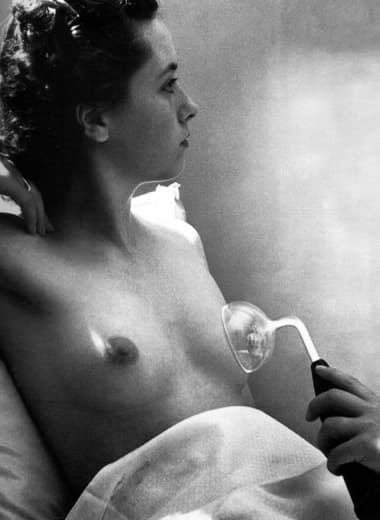
1947 High frequency being used as part of a bust treatment in a Rubinstein salon in Paris.
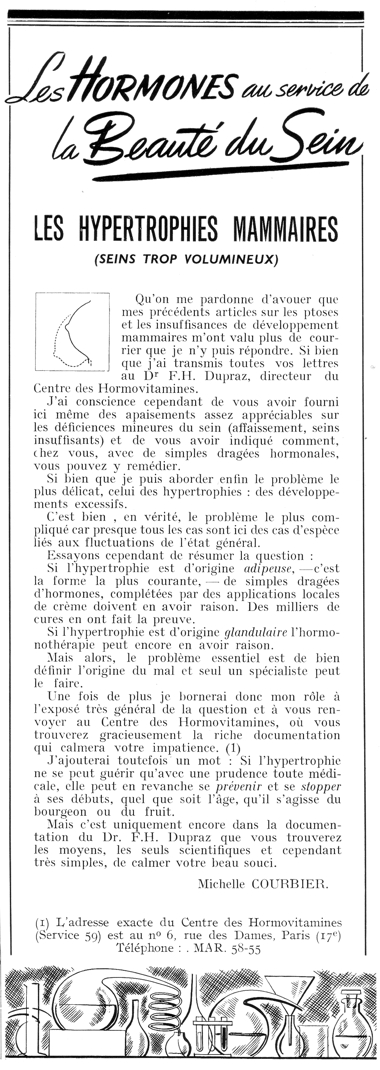
1949 Hormovitamines. This bust treatment was a mixture of creams and pills.
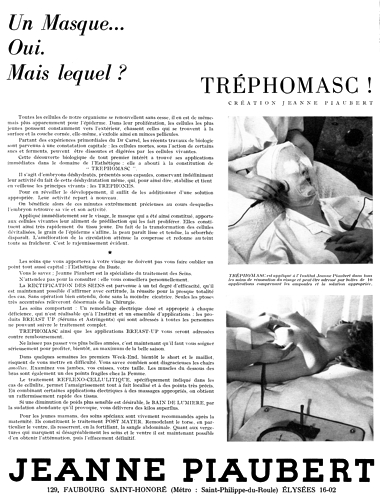
1949 Jeanne Piaubert treatments. One of these, appropriately titled ‘Breast Up’ used a combination or serums, astringents and electricity as an alternative to breast surgery.

1949 The Venus-Douche for conserving the bust.

1954 La Form bust cream with estrogenic hormones.

1958 Honor House bosom developer.
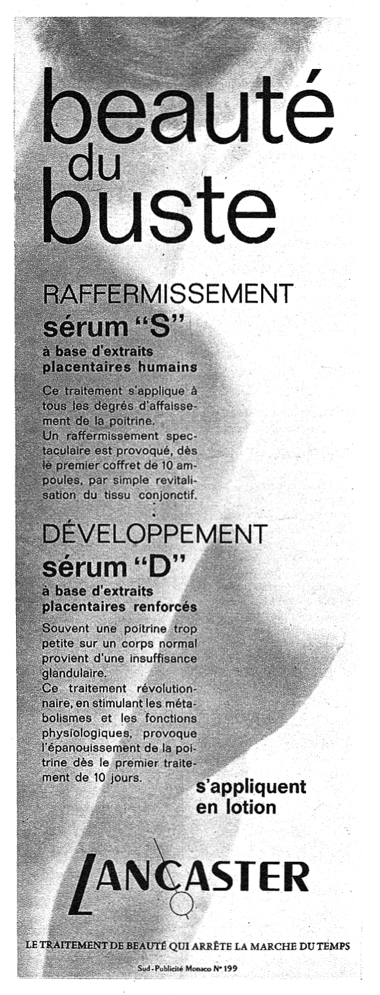
1961 Lancaster Sérum S for firming, and Sérum D for developing, the bust. Each contained placental extracts.
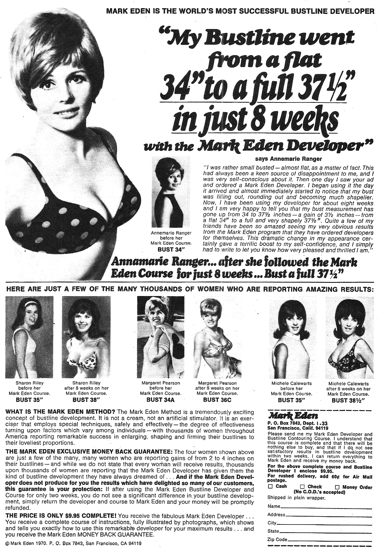
1970 Mark Eden.
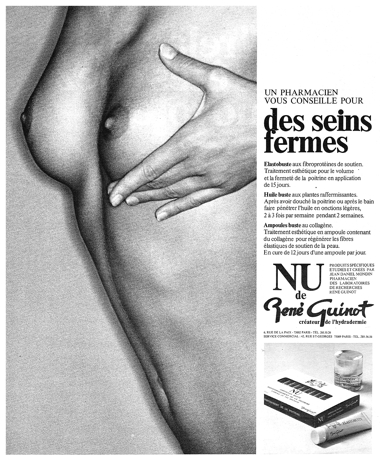
1978 Guinot Nu for firming the breast.

1983 Macrocell-D58. A bust cream that creates ‘cellular expansion’.
